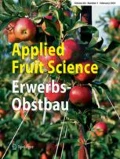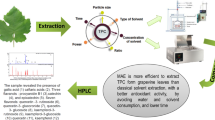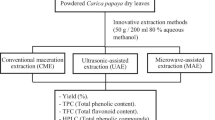Abstract
Grapevine leaves are consumed as a food in Mediterranean countries. At the same time, it is a byproduct of the wine industry. Antioxidant, antihypertensive and antidiabetic properties of grapevine leaves after ultrasound-assisted extraction (UAE), microwave assisted extraction (MAE) and classical solvent extraction (CSE) were evaluated and compared by using water and methanol as solvent. DPPH radical scavenging activity, total phenolic content (TPC), total antioxidant capacity (TEAC), metal chelating activity, ACE inhibitory activity and α‑glucosidase inhibitory activity of grapevine leaves extracts were determined. The highest values of grapevine leave extracts for antioxidant properties; DPPH (61.60%), TPC (910.18 mg GAE g−1), TEAC (6.23 µg Trolox mg−1) and metal chelating activity (IC50; 3.18 mg mL−1) were obtained from UAE when the methanol was used extracting solvent. However antihypertensive activity (13.68%) and antidiabetic activity (83.00%) values obtained from MAE by using water as a solvent were relatively highest. The effectiveness of UAE, MAE and CSE methods in terms of antioxidant, antihypertensive and antidiabetic properties of grapevine leaves were significantly (p < 0.05) different from each other. This differences depending on the solvent used.
Similar content being viewed by others
References
Abdel-Aal ESM, Akhtar H, Rabalski I, Bryan M (2014) Accelerated, microwave-assisted, and conventional solvent extraction methods affect Anthocyanin composition from colored grains. J Food Sci 79(2):C138–C146
Albu S, Joyce E, Paniwnyk L, Lorimer J, Mason T (2004) Potential for the use of ultrasound in the extraction of antioxidants from Rosmarinus officinalis for the food and pharmaceutical industry. Ultrason Sonochem 11(3):261–265
Alibaş İ (2012) Asma yaprağının (Vitis vinifera L.) mikrodalga enerjisiyle kurutulması ve bazı kalite parametrelerinin belirlenmesi. Tarım Bilim Derg 18(1):43–53
Alothman M, Bhat R, Karim A (2009) Antioxidant capacity and phenolic content of selected tropical fruits from Malaysia, extracted with different solvents. Food Chem 115(3):785–788
Ameer K, Bae S‑W, Jo Y, Lee H‑G, Ameer A, Kwon J‑H (2017) Optimization of microwave-assisted extraction of total extract, stevioside and rebaudioside-A from Stevia rebaudiana (Bertoni) leaves, using response surface methodology (RSM) and artificial neural network (ANN) modelling. Food Chem 229:198–207. https://doi.org/10.1016/j.foodchem.2017.01.121
Anđelković M, Radovanović B, Anđelković AM, Radovanović V (2015) Phenolic compounds and bioactivity of healthy and infected grapevine leaf extracts from red varieties Merlot and Vranac (Vitis vinifera L.). Plant Foods Hum Nutr 70(3):317–323
Aouey B, Samet AM, Fetoui H, Simmonds MSJ, Bouaziz M (2016) Anti-oxidant, anti-inflammatory, analgesic and antipyretic activities of grapevine leaf extract (Vitis vinifera) in mice and identification of its active constituents by LC–MS/MS analyses. Biomed Pharmacother 84:1088–1098. https://doi.org/10.1016/j.biopha.2016.10.033
Bertoncelj J, Doberšek U, Jamnik M, Golob T (2007) Evaluation of the phenolic content, antioxidant activity and colour of Slovenian honey. Food Chem 105(2):822–828
Bowyer MC, Van Vuong Q, Van Altena IA, Scarlett CJ (2015) Phytochemicals and antioxidant capacity of Xao tam phan (Paramignya trimera) root as affected by various solvents and extraction methods. Ind Crops Prod 67:192–200
Carbone K, Mencarelli F (2015) Influence of short-term postharvest ozone treatments in nitrogen or air atmosphere on the metabolic response of white wine grapes. Food Bioproc Tech 8(8):1739–1749. https://doi.org/10.1007/s11947-015-1515-y
Carocho M, Ferreira IC (2013) A review on antioxidants, prooxidants and related controversy: natural and synthetic compounds, screening and analysis methodologies and future perspectives. Food Chem Toxicol 51:15–25
Chen F, Zu Y, Yang L (2015) A novel approach for isolation of essential oil from fresh leaves of Magnolia sieboldii using microwave-assisted simultaneous distillation and extraction. Sep Purif Technol 154:271–280
Chuen TL, Vuong QV, Hirun S, Bowyer MC, Predebon MJ, Goldsmith CD, Sakoff JA, Scarlett CJ (2016) Antioxidant and anti-proliferative properties of Davidson’s plum (Davidsonia pruriens F. Muell) phenolic-enriched extracts as affected by different extraction solvents. J Herb Med 6(4):187–192
Cushman D, Cheung H (1971) Spectrophotometric assay and properties of the angiotensin-converting enzyme of rabbit lung. Biochem Pharmacol 20(7):1637–1648
Dahmoune F, Nayak B, Moussi K, Remini H, Madani K (2015) Optimization of microwave-assisted extraction of polyphenols from Myrtus communis L. leaves. Food Chem 166:585–595
Dent M, Dragovic-Uzelac V, Penic M, Brncic M, Bosiljkov T, Levaj B (2013) The effect of extraction solvents, temperature and time on the composition and mass fraction of polyphenols in Dalmatian wild sage (Salvia officinalis L.) extracts. Food Technol Biotechnol 51(1):84
Dinis TC, Madeira VM, Almeida LM (1994) Action of phenolic derivatives (acetaminophen, salicylate, and 5‑aminosalicylate) as inhibitors of membrane lipid peroxidation and as peroxyl radical scavengers. Arch Biochem Biophys 315(1):161–169
Durling NE, Catchpole OJ, Grey JB, Webby RF, Mitchell KA, Foo LY, Perry NB (2007) Extraction of phenolics and essential oil from dried sage (Salvia officinalis) using ethanol–water mixtures. Food Chem 101(4):1417–1424
Faostat F (2016) Food and Agriculture Organization of the United Nations, Production/Yield quantities of Grapes in World. http://fao.org/faostat/en/#data/QC/visualize. Accessed 06.11.2018
Farhadi K, Esmaeilzadeh F, Hatami M, Forough M, Molaie R (2016) Determination of phenolic compounds content and antioxidant activity in skin, pulp, seed, cane and leaf of five native grape cultivars in West Azerbaijan province, Iran. Food Chem 199:847–855
Hayta M, İşçimen EM (2017) Optimization of ultrasound-assisted antioxidant compounds extraction from germinated chickpea using response surface methodology. LWT Food Sci Technol 77:208–216
Katalinic V, Mozina SS, Generalic I, Skroza D, Ljubenkov I, Klancnik A (2013) Phenolic profile, antioxidant capacity, and antimicrobial activity of leaf extracts from six Vitis vinifera L. varieties. Int J Food Prop 16(1):45–60
Koşar M, Küpeli E, Malyer H, Uylaşer V, Türkben C, Başer KHC (2007) Effect of brining on biological activity of leaves of Vitis vinifera L.(cv. Sultani Cekirdeksiz) from Turkey. J Agric Food Chem 55(11):4596–4603
Król A, Amarowicz R, Weidner S (2015) The effects of cold stress on the phenolic compounds and antioxidant capacity of grapevine (Vitis vinifera L.) leaves. J Plant Physiol 189:97–104. https://doi.org/10.1016/j.jplph.2015.10.002
Kwon Y‑II, Vattem DA, Shetty K (2006) Evaluation of clonal herbs of Lamiaceae species for management of diabetes and hypertension. Asia Pac J Clin Nutr 15(1):107–118
Leopoldini M, Russo N, Toscano M (2011) The molecular basis of working mechanism of natural polyphenolic antioxidants. Food Chem 125(2):288–306
McDougall GJ, Shpiro F, Dobson P, Smith P, Blake A, Stewart D (2005) Different polyphenolic components of soft fruits inhibit α‑amylase and α‑glucosidase. J Agric Food Chem 53(7):2760–2766
Monagas M, Hernández-Ledesma B, Gómez-Cordovés C, Bartolomé B (2006) Commercial dietary ingredients from Vitis vinifera L. leaves and grape skins: antioxidant and chemical characterization. J Agric Food Chem 54(2):319–327
Orhan DD, Orhan N, Ozcelik B, Ergun F (2009) Biological activities of Vitis vinifera L. leaves. Turk J Biol 33:341–348
Orhan N, Aslan M, Orhan DD, Ergun F, Yeşilada E (2006) In-vivo assessment of antidiabetic and antioxidant activities of grapevine leaves (Vitis vinifera) in diabetic rats. J Ethnopharmacol 108(2):280–286. https://doi.org/10.1016/j.jep.2006.05.010
Palma M, Taylor LT, Varela RM, Cutler SJ, Cutler HG (1999) Fractional extraction of compounds from grape seeds by supercritical fluid extraction and analysis for antimicrobial and agrochemical activities. J Agric Food Chem 47(12):5044–5048
Priego-Capote F, Ruiz-Jiménez J, de Castro ML (2004) Fast separation and determination of phenolic compounds by capillary electrophoresis–diode array detection: application to the characterisation of alperujo after ultrasound-assisted extraction. J Chromatogr A 1045(1):239–246
Rababah TM, Banat F, Rababah A, Ereifej K, Yang W (2010) Optimization of extraction conditions of total phenolics, antioxidant activities, and anthocyanin of oregano, thyme, terebinth, and pomegranate. J Food Sci 75(7):C626–C632
Ranilla LG, Kwon Y‑I, Apostolidis E, Shetty K (2010) Phenolic compounds, antioxidant activity and in vitro inhibitory potential against key enzymes relevant for hyperglycemia and hypertension of commonly used medicinal plants, herbs and spices in Latin America. Bioresour Technol 101(12):4676–4689
Rostagno MA, Palma M, Barroso CG (2003) Ultrasound-assisted extraction of soy isoflavones. J Chromatogr A 1012(2):119–128
Sakulnarmrat K, Konczak I (2012) Composition of native Australian herbs polyphenolic-rich fractions and in vitro inhibitory activities against key enzymes relevant to metabolic syndrome. Food Chem 134(2):1011–1019
Santos LP, Morais DR, Souza NE, Cottica SM, Boroski M, Visentainer JV (2011) Phenolic compounds and fatty acids in different parts of Vitis labrusca and V. vinifera grapes. Food Res Int 44(5):1414–1418. https://doi.org/10.1016/j.foodres.2011.02.022
Shalaby EA, Shanab SM (2013) Comparison of DPPH and ABTS assays for determining antioxidant potential of water and methanol extracts of Spirulina platensis. Indian J Geomar Sci 42(5):556–564
Teixeira A, Baenas N, Dominguez-Perles R, Barros A, Rosa E, Moreno DA, Garcia-Viguera C (2014) Natural bioactive compounds from winery by-products as health promoters: a review. Int J Mol Sci 15(9):15638–15678
Vilkhu K, Mawson R, Simons L, Bates D (2008) Applications and opportunities for ultrasound assisted extraction in the food industry—a review. Innov Food Sci Emerg Technol 9(2):161–169
Vázquez-Delfín E, Robledo D, Freile-Pelegrín Y (2014) Microwave-assisted extraction of the carrageenan from Hypnea musciformis (Cystocloniaceae, Rhodophyta). J Appl Phycol 26(2):901–907
Xie Z, Huang J, Xu X, Jin Z (2008) Antioxidant activity of peptides isolated from alfalfa leaf protein hydrolysate. Food Chem 111(2):370–376
Author information
Authors and Affiliations
Corresponding author
Ethics declarations
Conflict of interest
M. Hayta and E.M. İşçimen declare that they have no competing interests.
Rights and permissions
About this article
Cite this article
Hayta, M., İşçimen, E.M. Antidiabetic, Antihypertensive and Antioxidant Properties of Grapevine Leaf Extracts Obtained by Ultrasound, Microwave Assisted, and Classical Solvent Extraction. Erwerbs-Obstbau 60 (Suppl 1), 79–85 (2018). https://doi.org/10.1007/s10341-018-0406-6
Received:
Accepted:
Published:
Issue Date:
DOI: https://doi.org/10.1007/s10341-018-0406-6




